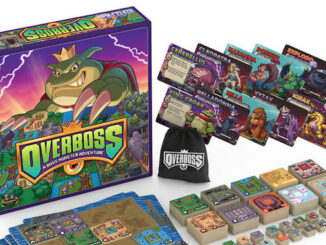Our review of Metal Gear Solid: Master Collection Vol. 1, developed by Konami. Available now for PS5 (reviewed), PS4, Xbox Series X/S, and, sort of, on Steam and Nintendo Switch (though by all accounts the Steam/Switch ports are nigh-well unplayable. Our review is based on the PS5 release, but we thought it worth the caveat.)
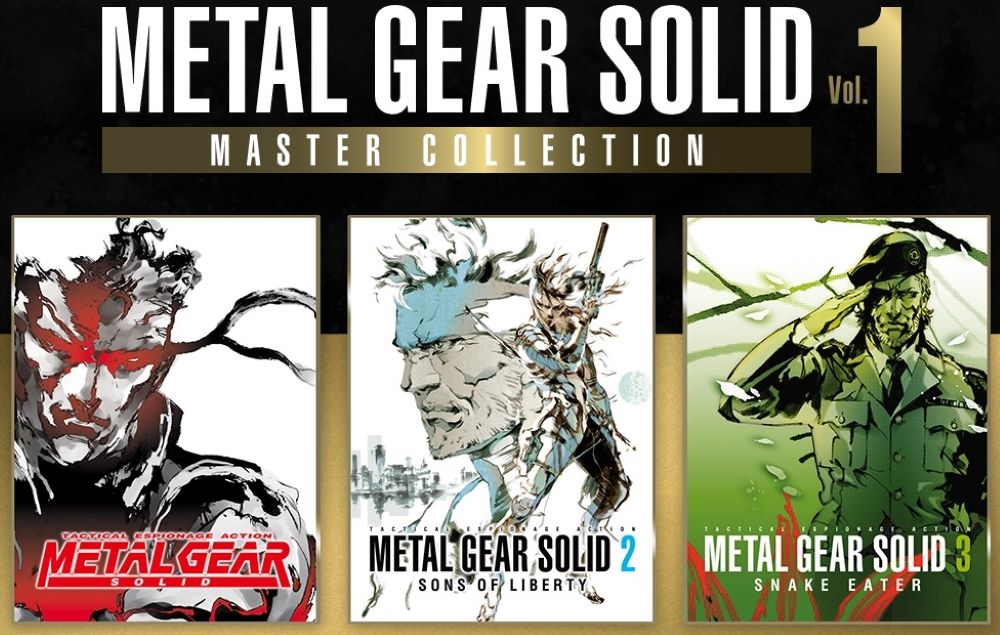
WHAT IS IT?
The classic Metal Gear Solid trilogy plus a few nice bonuses, all in one place.
IS IT GOOD?
It’s the classic Metal Gear Solid trilogy – perhaps my favourite video game trilogy of all time – all in one place, albeit lacking a proper HD upgrade.
WHO SHOULD PLAY IT?
Kurt Russell.
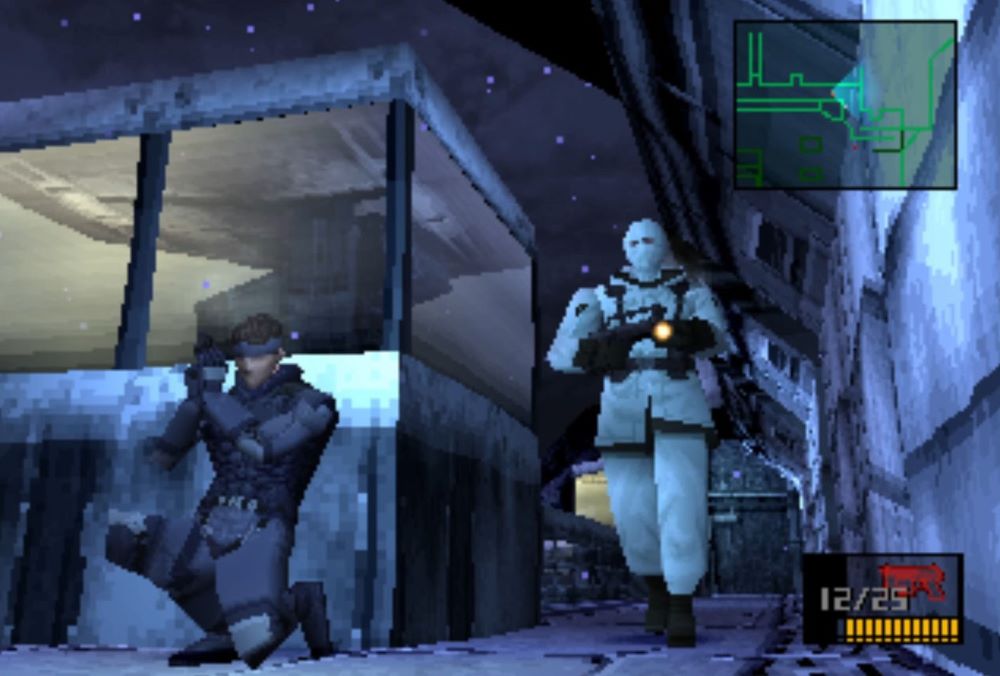
TACTICAL ESPIONAGE ACTION
Well folks, here it is. The long-overdue, hotly anticipated repackage of the greatest PlayStation trilogy of all time and the very first video game series I fell in love with, devouring every piece of internet gossip, ancillary media (I own the CD soundtrack boxset!), and even crafting my own fan-fiction (which I will never, ever share).
This package brings together – but does little in the way to remaster – the original Metal Gear (1987) and Metal Gear 2: Solid Snake (1990), alongside PlayStation classics Metal Gear Solid (1998), presented here in all its 32-bit pixelated glory, and the slightly retouched 2011 HD versions of Metal Gear Solid 2: Sons of Liberty (2001) and Metal Gear Solid 3: Snake Eater (2004). Virtual concept art galleries, the stellar “digital graphic novels” illustrated by Ashley Wood, and various other historical footnotes round out the package, but those hoping for any full-fledged remasters will need to wait for the upcoming Snake Eater remake Metal Gear Solid Delta (2024).
Do the MGS games – and their 8-bit predecessors – stand the rest of time? Absolutely. Are they a little rough around the edges? Well, that’s all just part of the charm.
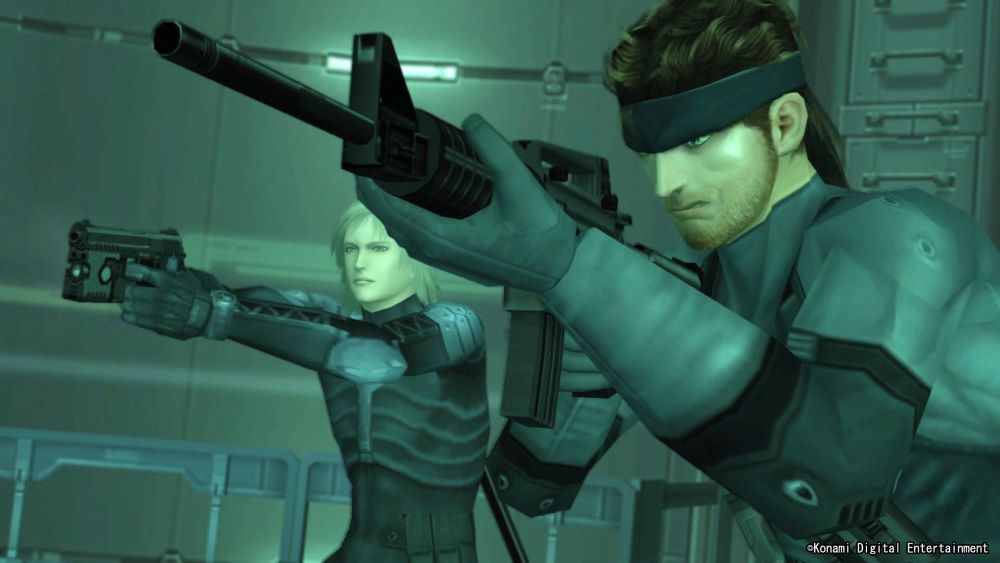
I LOVE TO RELOAD DURING BATTLE
At my age, certain gaming experiences are inextricably linked to feelings of deep, almost painful nostalgia.
I remember the countless hours in my neighbour’s basement, trying to brainstorm our way through Metal Gear Solid’s toughest challenges and most confusing puzzles, this in the days when walkthroughs took half an hour to load on Gamefaqs.com. I remember acquiring a PlayStation 2 around the release of Zone of the Enders, solely so I could play the enclosed demo of the upcoming Metal Gear Solid 2. In high school, my best friend nearly crashed his car after we stayed up all night blasting through a rented copy of Metal Gear Solid 3.
Metal Gear, it’s baked into my bones.
But there’s a good reason: it’s just so good. And interesting. And funny. And idiosyncratic in the way that only a certain breed of auteur – mad genius Hideo Kojima – could have created it.
WHAT’S A RUSSIAN GUNSHIP DOING HERE?
The original Metal Gear Solid (1998) is the easiest to explain. (And even then, it’s not that easy.)
Basically, it’s a spy thriller, its lead character a James Bond/Snake Plissken hybrid sent deep behind enemy lines to tackle a terrorist threat in remotest Alaska. The wintry setting is what gives the first MGS its incredible atmosphere, but it’s the story that makes it so compelling. A strange, anarchic concoction of nuclear doomsday/conspiracy theorizing/familial discord, it’s a game where, in the space of half an hour, you’ll go from an epic sniper duel to a confrontation with a psychic who not only knows you’re playing a video game, but identifies some of your favourite games. (MGS firmly established Kojima’s predilection for breaking the fourth wall, a gimmick that reached its zenith/nadir (depending on your point of view) with Death Stranding‘s in-game ads for Ride With Norman Reedus, a reality show starring the lead actor from… Death Stranding.)
Yet underneath all the absurdity (and impeccable gameplay, including some of the best boss fights in gaming), MGS tells a compelling, cinematic story, one heavily inspired by Hollywood blockbusters but taking advantage of the medium to do fun and wildly innovative things (like that part where Psycho Mantis reads your memory card and starts rhyming off games you’ve played). Its level design, which ranges from sub-sub basement storage facilities to trap-laden chambers to a snowy field where you’re stalked by wolf dogs, is second to none. Its stealth-based gameplay, in which you learn to prefer non-lethal and non-confrontational options, is tense and yet absurdly funny – one of the best ways to hide is to crouch under a cardboard box.
And its central characters – performed by a legendary cast led by Toronto’s own David Hayter as the gruff, gravelly voiced protagonist Solid Snake – remain some of the best and most fully fleshed out characters in gaming. (A category which also surely includes the sneeringly vicious Revolver Ocelot (Patric Zimmerman), who would go on to serve as a beloved recurring antagonist across the series.)
LA-LI-LU-LE-LO
Metal Gear Solid 2: Sons of Liberty (2001) is, by design, the odd one out. Gamers of a certain vintage will remember the controversy that met MGS2’s release, and the bold design gambit that Kojima pulled off. (And which, if we’re being honest here, he wouldn’t get away with today.)
Faced with immense pressure to deliver more of the same, Kojima pushed back, relegating Solid Snake to the sidelines of his own game, and featuring a character – Raiden – whose very existence serves as a riposte to the idea you can easily recreate a winning formula. After a breathless opening act, MGS2 reveals itself to be a rumination on game design itself, its in-game villains manipulating events in order to “breed the next Solid Snake”, as if simply replaying the hits will guarantee the same outcome. (Disney/Star Wars should take note.) By the game’s last act, when the stereotypical “fight the terrorists” plot is completely subsumed by MGS2‘s metafictional elements, you’re either utterly sold or entirely alienated. In any event, there’s nothing else quite like it in gaming.
That said, MGS2 represents, if nothing else, a major evolution for the series. The gameplay was perfected here, introducing a new first-person perspective (accompanying the traditional behind-the-shoulder view) that made the stealth and combat elements both easier and more sophisticated. (MGS2 does a lot of work with the player’s ever-shifting perspectives.) Pretty boy Raiden, while obnoxiously and almost comically inexperienced at first, eventually proves himself to be a worthy hero in his own right, even if he’s not the hero he was “designed” to be. Unsurprisingly for a game which doubles as a metafictional meditation on authorial control, MGS2 is also where the series dives headlong into its wildest conspiratorial aspects, tackling notions of free will, artificial intelligence, and collective memory.
Most importantly, MGS2 properly introduces the decades-old secret organization which will come to haunt the series for the next fifteen years. In a stroke of genius, this shadowy cabal’s identity remains maddeningly vague throughout the game: thanks to some in-game brainwashing, whenever someone says a certain name out loud, all that Raiden – and, by extension, the player – hears is the nonsensical phrase “La-Li-Lu-Le-Lo”. It’s not the first, and certainly not the last bit of fourth wall-breaking fun that MGS has at the player’s expense, but it’s one of the best. (Like its predecessor, MGS2 also has an incredible fourth wall-shattering moment meant to trick players into thinking it’s “game over”.)
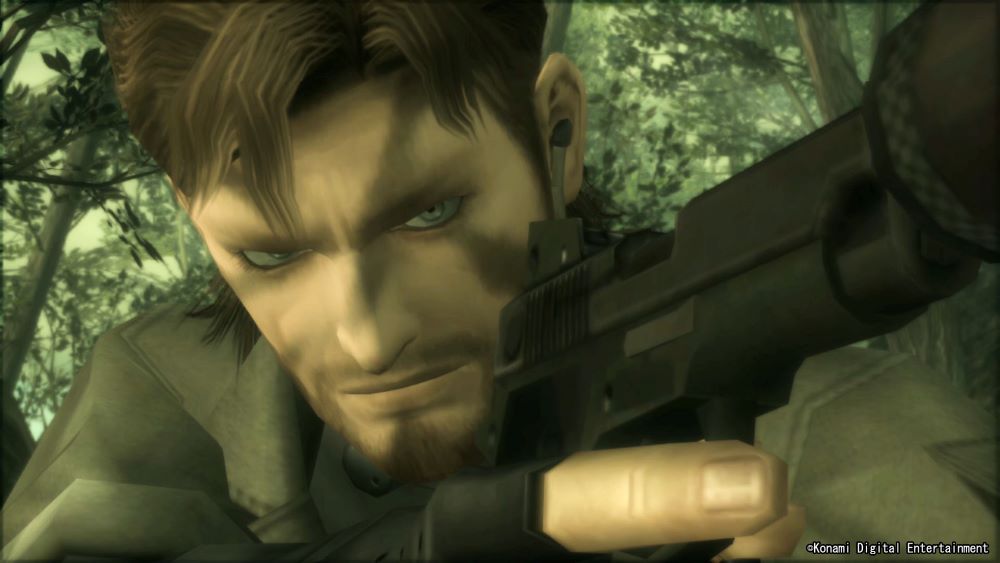
TILL WE MEET AGAIN, JOHN
Metal Gear Solid 3: Snake Eater (2004) represents another bold choice: for the second game in a row, nominal series protagonist Solid Snake is relegated to the background. In this case, though, it’s because he hasn’t been born yet.
A 1960s-set prequel which gleefully embraces the series’ espionage elements, Snake Eater is the most Bondlike of Metal Gears, featuring a rogue Soviet super-soldier, a beautiful and dangerous femme fatale, and a glorious – glorious – title theme that ranks among the best Bond themes of all time. Starring a secret agent known only as codename “Naked Snake” – a dead ringer for Solid Snake, for what that’s worth – Snake Eater again radically transforms the series, this time as a slower, more methodical journey deep into a remote Soviet jungle. Cardboard boxes are out; swappable paint camouflage is in.
Snake Eater wisely reins in the fantastical elements after the unconventional MGS2, ably balancing more traditional spycraft with the series’ underlying conspiratorial themes, and laying the groundwork for some major revelations in the subsequent Metal Gear Solid 4. (Which is not to say MGS3 doesn’t also feature a character who’s the video game equivalent of Bumblebee Man.)
Snake Eater‘s best feature is its jungle setting, which breaks free of the confines of the largely indoor settings of prior games, giving players – and enemies – new and exciting ways to interact with the world. Snake Eater‘s second-best feature is the relationship at its heart – not the one between Snake and double/triple/quadruple agent EVA (inspired by a Bond Girl in From Russia With Love), but the one between Snake and a haughty young Soviet gunfighter codenamed Ocelot, years before he became the cruel Revolver Ocelot of the other games. Young Ocelot elevates every scene he’s in, a delightful, cocksure presence who’s always playing more angles than even he can keep track of, and who seems to be the only one having fun. (The most audacious thing about Ocelot? In a series that consistently breaks the fourth wall, he manages to give the impression of knowing it’s all a game, without ever feeling the need to say so or otherwise wink at the audience.)
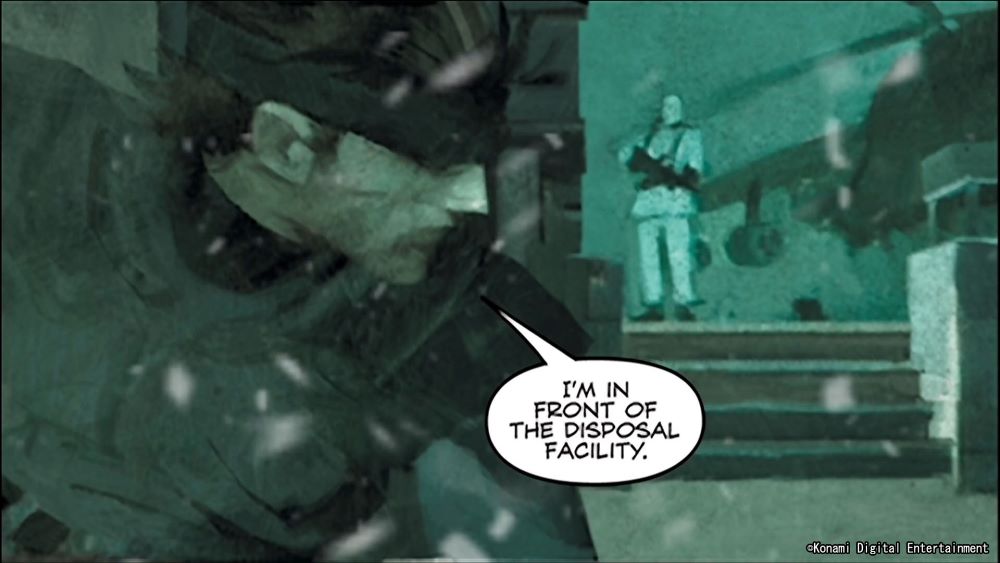
WAR HAS CHANGED
You will note I have not yet mentioned the machines for which this series is named.
In a sense, the “Metal Gears” – giant, hulking robots that look like a cross between ED-209 and Godzilla – are the MacGuffins of MGS. Each game is centered around a race to stop the latest giant robot threat – and yes, the battles against them are fantastic – but they aren’t the heart of the series. Instead, they’re the inciting incident, the stolen nuclear warhead or missing submarine of James Bonds past; the thing that puts events in motion, enabling Kojima to tell a much richer, more complex story – of family ties (MGS1), iterative design (MGS2), or classic spycraft (MGS3) – than one might expect from their outward trappings.
I also haven’t really discussed the man himself, Metal Gear creator Hideo Kojima. Kojima is a legend, but he’s also an enigma: after delivering eight straight games of perfectly imperfect tactical espionage action – Metal Gear and Metal Gear 2 on the original MSX (also included in this package, though likely too dated for most gamers), Metal Gear Solid 1-4, the portable gems MGS Portable Ops and MGS Peace Walker – Kojima himself went rogue, delivering the bizarre, clumsy, ill-advised, and aggressively sexist MGS V: The Phantom Pain (2015).
MGS V (which, like its immediate precedessor MGS4, is not included in this package) jettisoned most of what we love about the series – including voice actor David Hayter, replacing him with fellow Canadian Kiefer Sutherland in one of the worst recastings of all time – and told a story that consciously sought to undermine everything we knew about the “Snake” family. After the production process on Phantom Pain fell apart – much of it, to be clear, the fault of corporate overlords at Konami – Kojima walked away, founding his own studio and releasing the equally bizarre, painfully slow Death Stranding (of which you can read more about here). Today, Kojima remains involved, somewhat, in the perennially delayed production of the mooted Metal Gear movie, but it’s clear the man has moved on: he told the story he needed to tell (even if he whiffed the ending so badly it’s better to pretend MGS V never happened), and these days it’s Norman Reedus who occupies his time.
That may be a wistful note to end on, but Metal Gear – a series deeply invested in questions of legacy – wouldn’t be the same without its imperfections. From that first (double-disc!) 1998 release which loudly proclaimed, “games can be movies too!”, to the player-defying madness of Metal Gear Solid 2, to the James Bond homage of MGS3, the Master Collection is an essential showcase for the series on which a generation of gamers was raised. While it lacks some key later entries – the “interquel” titles Portable Ops (2006, great) and Peace Walker (2010, essential) and the series-capping epic Metal Gear Solid 4: Guns of the Patriots (2008), the Collection is absolutely worth your time, whether you are a new or returning player.
Till we meet again…
***
Final score: 10/10
Visit the official website for Metal Gear Solid: Master Collection Vol. 1 here.
Rumours about Master Collection Vol. 2 abound, but expect lightly touched-up versions of the excellent MGS 4 and mediocre MGS V; maybe if we’re lucky, Konami will throw in the fantastic Metal Gear Ac!d deck-builder games as well.

